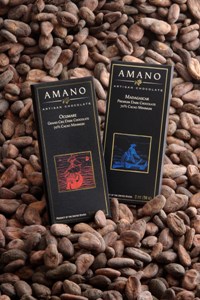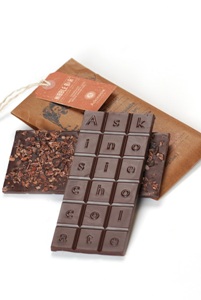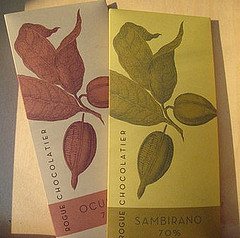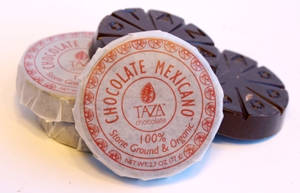Special Feature: Products Sally Recommends
The Mavericks of American Chocolate
 Anyone who makes the decision to start a small-scale food business in the US has to be pretty darned brave. There’s so much competition, you need significant financial backing, ingredients are expensive when you buy them in smaller quantities, etc., etc. This applies especially to chocolatiers, it seems to me. In the past fifteen or so years, the number of chocolatiers in this country has simply exploded, and that appears to apply across the board, from those who produce relatively inexpensive, chocolate-covered treats to those who make the most high-end, upscale, delicate and exotic bonbons.
Anyone who makes the decision to start a small-scale food business in the US has to be pretty darned brave. There’s so much competition, you need significant financial backing, ingredients are expensive when you buy them in smaller quantities, etc., etc. This applies especially to chocolatiers, it seems to me. In the past fifteen or so years, the number of chocolatiers in this country has simply exploded, and that appears to apply across the board, from those who produce relatively inexpensive, chocolate-covered treats to those who make the most high-end, upscale, delicate and exotic bonbons.
If you want to find people with true nerves of steel, however, I will refer you to those who are chocolate-makers. What’s the difference? A chocolate-maker manufactures the actual bean-to-bar chocolate, the basis of the chocolatier’s work. There are a number of large companies who manufacture chocolate by the ton, of course. But there’s a new breed of chocolate-maker in the US these days. These Davids are taking on the Goliaths of the chocolate world, and it’s an enormous challenge. Making chocolate is a complex and lengthy process that involves everything from sourcing cacao beans to overseeing their harvest and fermentation to roasting and conching to determining quantity of sugar in the bar to the molding of the bars. Most of these small-scale entrepreneurs somehow find cacao beans that are up to their exacting standards; many go to the places where the cacao is grown and forge relationships with growers. All must negotiate the maze of paperwork (and fees) for exporting and importing and find suitable equipment and a halfway decent place to manufacture…all of which has to be done before they can even make any chocolate! It also helps, I take it, if you can convince your loved ones that you haven’t suddenly gone mad. After all, this is a terribly expensive proposition that will leave you very little time for anything else. Even when you finally have everything in place, there’s no guarantee you’ll succeed. You’ve still got to get the word out about your product (with a very limited advertising budget, yet) and hope that it finds favor with a notoriously fickle American public. Tell me, do you have enough intestinal fortitude to tackle something like this?
I’m not sure I do. Fortunately for me and those of you like me, a few hardy souls in this country have decided that this is their true calling. If you want to know why they’ve chosen to tread such a stony path, well, you’ll have to ask them. In the meantime, you can try the fruits of their labors via a mere few clicks of your mouse. You may well have heard of a few of these micro-manufacturers, as they have achieved some success, but it’s likely that others will be new to you, as they were to me until quite recently. And please don’t ask me which of these manufacturers produces the “best” chocolate! I could, of course, pontificate on my chocolate likes and dislikes all day, but that’s not why I write about chocolate. The idea here is to tell you about chocolates of which you were unaware, so you can try something new and (hopefully) find products you really enjoy. Because when it comes down to it, the task of determining the “best” chocolate is really up to your preferences; it’s all about what works best for you.
While there is some great chocolate being made in other countries (such as The Omanhene Cocoa Bean Company’s chocolate, made in Ghana), for the purposes of this article I’ll concentrate solely on chocolate being made within the United States. Bear in mind that these artisanally-produced bars and other products will cost more than supermarket chocolate! These are specialty foods, produced in quantities that would cause large manufacturers to laugh outright, and they’re made by people who care deeply about what they’re doing. Because these are small-scale producers, you’re going to have to expect that they may sometimes run out of product, especially shortly before any major chocolate holidays. Many of these chocolates are single-origin, meaning that the cacao beans used to make them were grown in one region (sometimes, that region is as small as one plantation or estate). Chocolate-makers are listed in alphabetical order; all have online ordering except where noted.
---Amano Artisan Chocolate, www.amanochocolate.com.
 Art Pollard is the public face of Amano. I admire Mr. Pollard very greatly for several reasons. Not only does he work directly with individual cacao growers (not brokers) and pay them higher-than-Fair Trade ™ prices (a number of manufacturers listed here do that, as you’ll see), but he has an uncommon devotion to his craft. For instance, it took him ten years to do his research, develop his methodology, make his machinery (!), study chocolate-making, source his beans, etc., before he began selling chocolate he had made. The Salt Lake City area (where the manufacturing facility is located) was selected because Mr. Pollard believes the altitude and climate aid in the chocolate’s flavor development process. And, unlike a number of manufacturers who boast about the length of time their chocolate is conched (for more explanation of conching, see the Taza Chocolate listing), Amano is conched “until it is done”. If this isn’t an indication of a “hands-on” approach to making chocolate, I’m sure I don’t know what is. Currently available in three different regional bars (all dark), a 10 bar variety pack, and untempered chunks in bulk packaging for chefs.
Art Pollard is the public face of Amano. I admire Mr. Pollard very greatly for several reasons. Not only does he work directly with individual cacao growers (not brokers) and pay them higher-than-Fair Trade ™ prices (a number of manufacturers listed here do that, as you’ll see), but he has an uncommon devotion to his craft. For instance, it took him ten years to do his research, develop his methodology, make his machinery (!), study chocolate-making, source his beans, etc., before he began selling chocolate he had made. The Salt Lake City area (where the manufacturing facility is located) was selected because Mr. Pollard believes the altitude and climate aid in the chocolate’s flavor development process. And, unlike a number of manufacturers who boast about the length of time their chocolate is conched (for more explanation of conching, see the Taza Chocolate listing), Amano is conched “until it is done”. If this isn’t an indication of a “hands-on” approach to making chocolate, I’m sure I don’t know what is. Currently available in three different regional bars (all dark), a 10 bar variety pack, and untempered chunks in bulk packaging for chefs.
---Askinosie Chocolate, www.askinosie.com.
 Shawn Askinosie had been a criminal defense lawyer for almost two decades; the inspiration to make chocolate from its basic raw material came to him suddenly while attending the funeral of an elderly relative. Mr. Askinosie is proud of the fact that he pays prices for his cacao beans that are higher than those mandated by Fair
Shawn Askinosie had been a criminal defense lawyer for almost two decades; the inspiration to make chocolate from its basic raw material came to him suddenly while attending the funeral of an elderly relative. Mr. Askinosie is proud of the fact that he pays prices for his cacao beans that are higher than those mandated by Fair
Trade ™ policies. He also travels to Ecuador and Mexico and shares 10% of the profits from his chocolate with the farmers who grew the beans. In fact, the names and photos of his “lead farmers” appear on his packaging. He’s a great believer in working with and teaching farmers, as well as traceability of the ingredients used in his products. These products contain no vanilla, as Mr. Askinosie seeks to coax great flavor from his beans “without the enhancement of other flavors”. Currently manufacturing a 70% cacao bar from Ecuador and a 75% cacao bar from Mexico. Each bar is available in two sizes; each is also available plain or with the addition of cacao nibs (in the smaller size only). Also sipping chocolate (in the same 70% and 75% formulae), a couple of clever gifts, and a single origin natural (nonalkalized) cocoa powder.
---De Vries Chocolate, www.devrieschocolate.com. Steve De Vries is a man obsessed. As I write this, he has recently gone off on yet another month-long trip to a far-flung, cacao-producing region, all in the name of sourcing great beans for his products. Mr. De Vries eschews the use of vanilla, feeling that it detracts and distracts from the true taste of the chocolate. The company slogan is “one hundred years behind the times”, and this chocolate is indeed manufactured on vintage equipment, with great care. Even if I had never met Mr. De Vries nor tried his chocolate, I’d have to respect him for one aspect of his philosophy. He dismisses anything you read or hear about chocolate as “window dressing”, adding that “Chocolate is about what happens in your mouth. Don’t listen to what anyone tells (you) until you listen to your own taste buds.” This is one of very few absolute truths I’ve ever seen about chocolate, and I applaud him for it. Currently offering three different bars made with Costa Rican beans, three different bars made with beans from the Dominican Republic, Caramelized Cocoa Nib Clusters, Caramelized Nibs, and the mysteriously-named “Nib Giants”.
---Mast Brothers Chocolate, www.mastbrotherschocolate.com. Brothers Rick and Michael Mast are opening their chocolaterie in the Williamsburg section of Brooklyn, but they’re not open to the public yet. They are making a very limited quantity of chocolate, but everything they make “sells the same week”, according to Rick. Currently, they sell only to a few area stores and at their local flea market; see the website for more information. The brothers hope to open fully in the summer of 2008. No online ordering as of this writing, of course.
---Patric Chocolate, www.patric-chocolate.com. Another small-scale producer bent on creating only dark chocolate, at least according to their blog (which has a great explanation of the manufacturing process). This chocolate is produced without the addition of vanilla. Alan McClure, head honcho here, is at some pains to note that, by themselves, Criollo beans, or hybrids heavy in Criollo, do not a fine chocolate make, a point too often lost in a world that is driven by catchwords. There is also emphasis here on the fact that the chocolate is made in micro-batches. I’m a little confused by the current offerings, given that one is a 67% bar made from beans grown in Madgascar’s Sambirano Valley, and the other is a 70% bar made from beans grown in…the same place. Will most people be able to determine any significant difference in flavor between the two? Perhaps. Presumably, however, other bars from other regions will round out the roster eventually; this is quite a young company. Also offered are a Selection of the Month and a bar collection.
---Rogue Chocolatier, www.roguechocolatier.com.
 I do not know what you were doing when you were in your early 20’s, gentle reader, but Colin Gasko, Founder and Chocolate Maker at Rogue, was starting his own chocolate manufacturing business, perhaps the ultimate combination of ambition and optimism. Based in Minneapolis, Mr. Gasko turns out beautifully-packaged bars, often in limited editions (fewer than one thousand bars of both the Trinidad and Jamaica chocolates will be produced). Most bars are named after the regions in which the cacao beans used to make them were grown (the Ocumare Bar, for instance, uses beans from the Valley of Ocumare in Venezuela). Mr. Gasko prints brief tasting notes on his packages (for example, the Trinidad indicates that the bar contains flavors of coconut, honey, and passionfruit, while the Jamaica lists “earth, raspberry, nuts” as a flavor profile). Currently, five varieties of chocolate bar are sold online.
I do not know what you were doing when you were in your early 20’s, gentle reader, but Colin Gasko, Founder and Chocolate Maker at Rogue, was starting his own chocolate manufacturing business, perhaps the ultimate combination of ambition and optimism. Based in Minneapolis, Mr. Gasko turns out beautifully-packaged bars, often in limited editions (fewer than one thousand bars of both the Trinidad and Jamaica chocolates will be produced). Most bars are named after the regions in which the cacao beans used to make them were grown (the Ocumare Bar, for instance, uses beans from the Valley of Ocumare in Venezuela). Mr. Gasko prints brief tasting notes on his packages (for example, the Trinidad indicates that the bar contains flavors of coconut, honey, and passionfruit, while the Jamaica lists “earth, raspberry, nuts” as a flavor profile). Currently, five varieties of chocolate bar are sold online.
---Taza Chocolate, www.tazachocolate.com.
 A most unusual chocolate manufacturer, based in Somerville, MA. The chocolate is certified organic. It is stone-ground; I don’t know of anyone else who is grinding their beans using only traditional stone mills. Taza also omits a manufacturing step that most consider crucial: they do not conche. Conching, if you don’t know, is an agitation process. There’s debate on whether it further develops the chocolate’s flavor, and gets rid of some bitterness and some volatile acids. One thing conching does do, however, is produce a smoother texture. During the conching process, particles of sugar and cacao become rounded and coated with cocoa butter, and a lack of edges on these particles means a smoother chocolate. The lack of conching means that Taza bars are not entirely smooth. If that sounds unpleasant, remember that smooth chocolate is a relatively recent innovation; try some of this for yourself and see if you like the texture. Taza also pays higher than Fair Trade ™ prices for their beans, and they trade directly with small farming co-ops. Currently offering a couple of gift assortments, t-shirts, shaved chocolate in a shaker (“Shakey Chocolate”), nibs, bars in three cacao percentages (60, 70, and 80), and “discs” in Cinnamon and Almond flavors.
A most unusual chocolate manufacturer, based in Somerville, MA. The chocolate is certified organic. It is stone-ground; I don’t know of anyone else who is grinding their beans using only traditional stone mills. Taza also omits a manufacturing step that most consider crucial: they do not conche. Conching, if you don’t know, is an agitation process. There’s debate on whether it further develops the chocolate’s flavor, and gets rid of some bitterness and some volatile acids. One thing conching does do, however, is produce a smoother texture. During the conching process, particles of sugar and cacao become rounded and coated with cocoa butter, and a lack of edges on these particles means a smoother chocolate. The lack of conching means that Taza bars are not entirely smooth. If that sounds unpleasant, remember that smooth chocolate is a relatively recent innovation; try some of this for yourself and see if you like the texture. Taza also pays higher than Fair Trade ™ prices for their beans, and they trade directly with small farming co-ops. Currently offering a couple of gift assortments, t-shirts, shaved chocolate in a shaker (“Shakey Chocolate”), nibs, bars in three cacao percentages (60, 70, and 80), and “discs” in Cinnamon and Almond flavors.
---TCHO, https://tcho.com. The “T” is for technology, and the “CHO” is short for chocolate. TCHO describes themselves as being “serious about chocolate”. For the present, at least, all product is available only in limited editions, and the lovers of milk and white chocolates among us must go elsewhere, as TCHO makes only dark chocolate. Although the company claims to have developed “a new taxonomy to help you find the chocolate you like”, the terms they employ (nutty, fruity, chocolatey, etc.) have been around for years now. I’m not sure I’ve ever received as intensely chocolatey an aroma from any other package of chocolate I’ve opened as I did from TCHO’s Beta Batch C Ghana 0.7 AH, which is good, as this product was supposed to be one of their “chocolatey” examples. The chocolate I tried had a hint of graininess to it, an effect some producers are trying for in these days of chocolate diversity. I appreciate the fact that TCHO is looking to go beyond Fair Trade ™, by imparting knowledge to cacao growers so they can produce a better product for which they are paid more, instead of a commodity. Manufactured in San Francisco. Currently, one variety offered…but that variety changes frequently. The company is looking to have its “gold standard” products online by early summer.
---Theo Chocolate, www.theochocolate.com. If you’ve heard of anyone in this article, it’s most likely to be Theo. They have the most extensive product line and best distribution of any manufacturer listed here. Theo also manufactures chocolate under the brand name “3400 Phinney”. All cacao beans used in Theo/3400 Phinney Chocolate are both organic and Fair Trade ™ certified. Of the chocolate made from these beans, all of the 3400 Phinney bars are certified organic, but not so the Theo single-origin bars. The company currently offers five single origin bars (all dark) in the Theo line; the 3400 Phinney bars include four milk chocolate varieties (I like the Vanilla Milk Chocolate) and four dark chocolate varieties (the most unusual is a Fig, Fennel, & Almond Dark). Also available are cacao nibs, nut brittle (plain and enrobed), sipping chocolate, bonbons, and a few gift ideas, such as the innovative Wine Pairing Kit, a 5-bar assortment designed to go with red wine.
---The Original Hawaiian Chocolate Factory, www.originalhawaiianchocolatefactory.com. The only producers to raise their own cacao trees in Hawai’i and process the beans there. Bob and Pam Cooper moved from North Carolina to the Kona coastline in 1997 and began growing coffee…and then cacao. This “estate” chocolate is available in both milk and dark, in 3 ounce bars, one pound bars, and bite-sized pieces called “plumerias”, named after a tropical flower common in the islands. This chocolate is not as intense in flavor as some others reviewed here; sometimes, that can be a welcome break! The company also sells t-shirts and their own estate-grown Kona coffee. The boxes for the chocolate seem a little old-fashioned, somehow, but to me that’s part of their appeal.
![]()
Stephanie (HandOverTheChocolate@comcast.net) has had a strong affinity for chocolate from a very early age. Family members claim that, as a child, she was able to hear chocolate being opened in the kitchen no matter where she was in the house. Stephanie was baking by the time she was 6 and ran a short-lived baking business out of her parents’ kitchen when she was in high school. She has a Master’s Degree in Foods from Virginia Tech but no formal training in cooking or baking. Consequently, she is a home cook, not a chef. Prior to beginning this column, she had written about chocolate for some 8 years.
Note: This information was accurate when it was published. Please be sure to confirm all rates and details directly with the businesses in question before making your plans.



